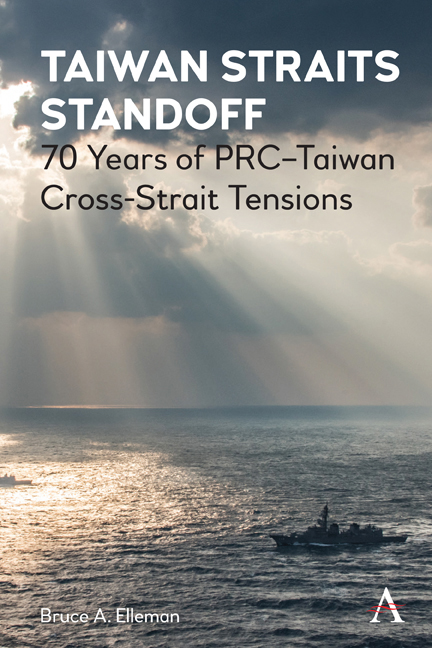Book contents
- Frontmatter
- Dedication
- Contents
- List of Illustrations
- Introduction: Stalemate along the Taiwan Straits, 1949–2020
- 1 The Two Chinas and the Battle for Control of Offshore Islands
- 2 President Harry S. Truman’s Decision to Protect Taiwan
- 3 The First Taiwan Strait Crisis, 1954–55
- 4 The Evacuation of the Dachen Islands, 1955
- 5 The Second Taiwan Strait Crisis, 1958
- 6 The US Threat to Use Atomic Weapons
- 7 Using Taiwan to Undermine the Sino-Soviet Alliance
- 8 Taiwan during the Cold War and Afterward
- Conclusions: The Taiwan Strait’s Strategic Significance Today
- Appendix: Naval Terms and Acronym List
- Selected Bibliography
- Index
1 - The Two Chinas and the Battle for Control of Offshore Islands
- Frontmatter
- Dedication
- Contents
- List of Illustrations
- Introduction: Stalemate along the Taiwan Straits, 1949–2020
- 1 The Two Chinas and the Battle for Control of Offshore Islands
- 2 President Harry S. Truman’s Decision to Protect Taiwan
- 3 The First Taiwan Strait Crisis, 1954–55
- 4 The Evacuation of the Dachen Islands, 1955
- 5 The Second Taiwan Strait Crisis, 1958
- 6 The US Threat to Use Atomic Weapons
- 7 Using Taiwan to Undermine the Sino-Soviet Alliance
- 8 Taiwan during the Cold War and Afterward
- Conclusions: The Taiwan Strait’s Strategic Significance Today
- Appendix: Naval Terms and Acronym List
- Selected Bibliography
- Index
Summary
This book will examine the role of offshore islands in twentieth-century East Asian history, and in particular those islands located in the Taiwan Strait that were disputed by the People's Republic of China (PRC) and the Republic of China (ROC) during the 1950s and afterward, and how these apparently insignificant islands impacted Cold War history. The history of the 1945–91 Cold War can be divided into three parts: (1) breaking apart the Sino-Soviet monolith, (2) forging Sino-US cooperation against the USSR, and (3) the two-front destruction of the USSR. The Harry S. Truman Presidential Library and the Dwight D. Eisenhower Presidential Library contain especially pertinent information on the first of these three periods, allowing for a greater understanding of how and why Washington adopted polices with the strategic goal of breaking apart the Sino-Soviet alliance.
For much of this period, from 1950 to 1979, the US Navy (USN) conducted a buffer operation in the Taiwan Strait to neutralize the region. The most important goal of this USN operation was to ensure that neither side attacked the other, an action that might lead to global war. While it is often assumed that the US government's focus was just on the Taiwan Strait, in fact there were equally valid concerns that after “China is Communized, the remainder of Asia and the islands to the south and east will be vulnerable to rapid Communization”; due to East Asia's geography, “there are no natural barriers to the advance of Communism from China to Indo-China, Siam, Burma and thence to Malaya, India, Indonesia and the other islands of the Western Pacific.” Because of the enormous Nationalist losses, by late 1949 America's defense line had moved from the China's Pacific Coast to the various islands from the Aleutians, down through the Kurils, Hokkaido, the main Japanese islands, Okinawa, Formosa [Taiwan], and the Philippines. In particular, “Formosa is in the direct line—in fact, it is the center of our whole defense.”
Seen in this perspective, the defense of Taiwan was essential to the defense of all of East Asia.
- Type
- Chapter
- Information
- Taiwan Straits Standoff70 Years of PRC–Taiwan Cross-Strait Tensions, pp. 3 - 22Publisher: Anthem PressFirst published in: 2021



